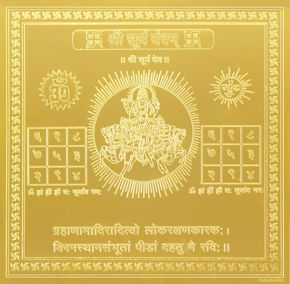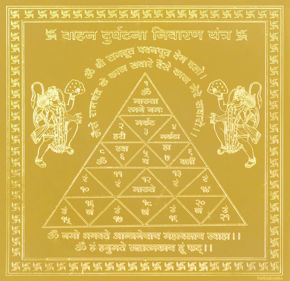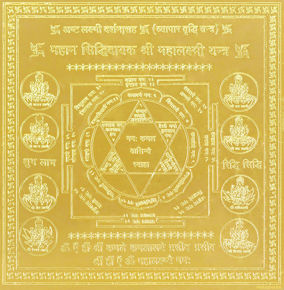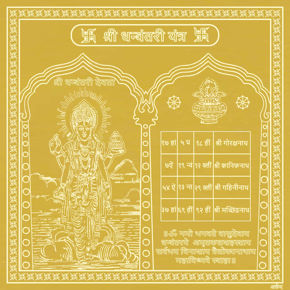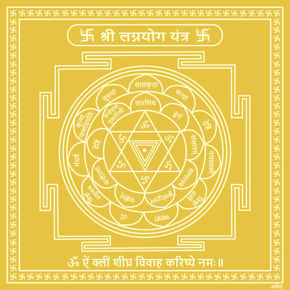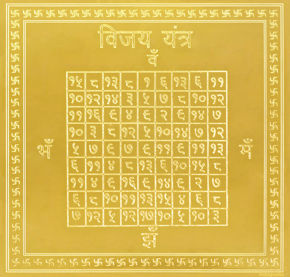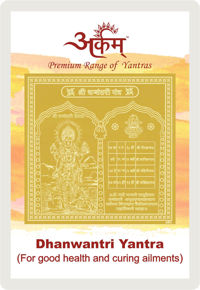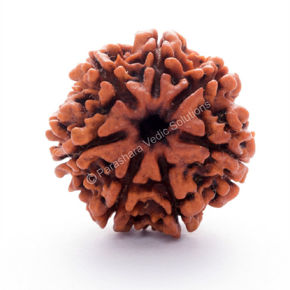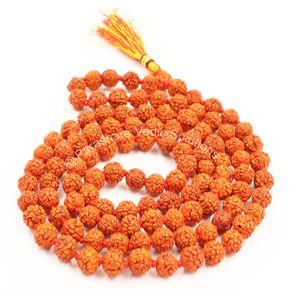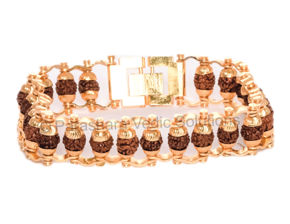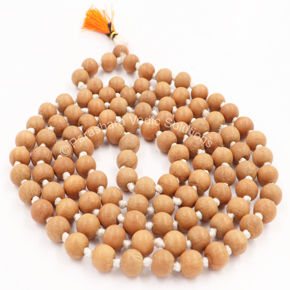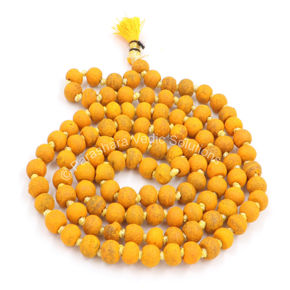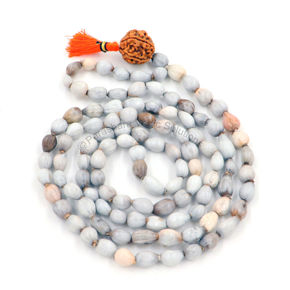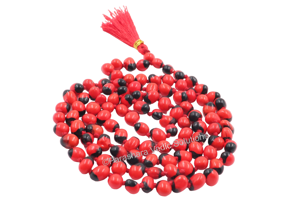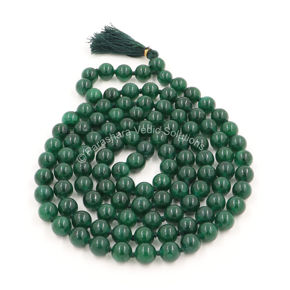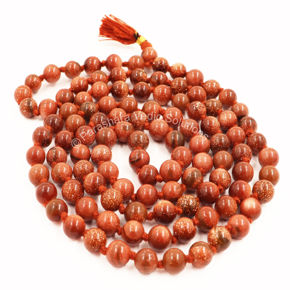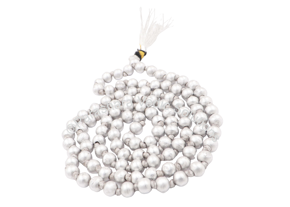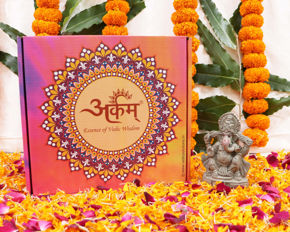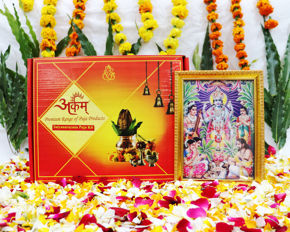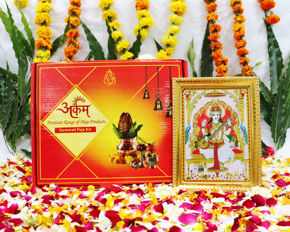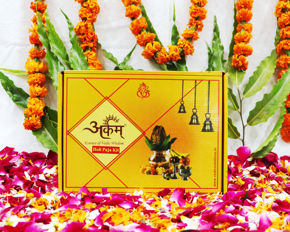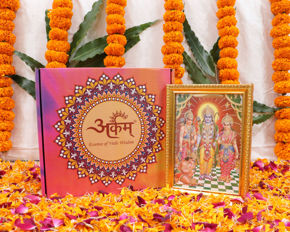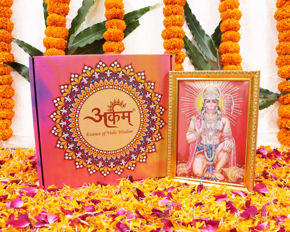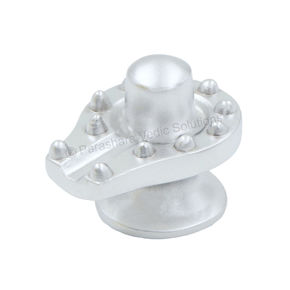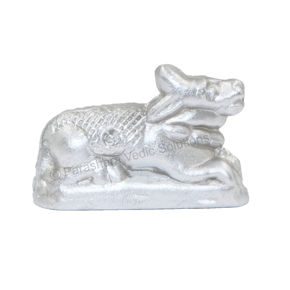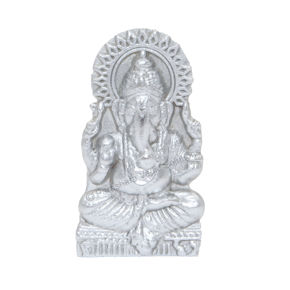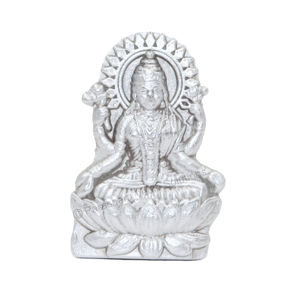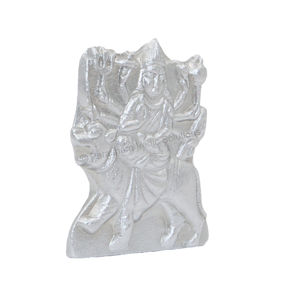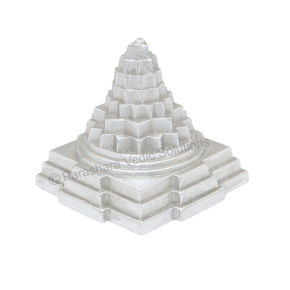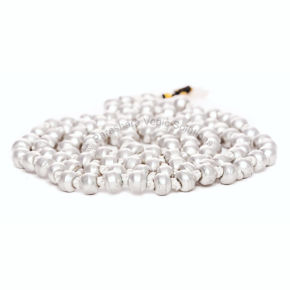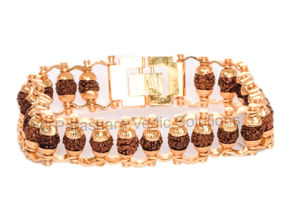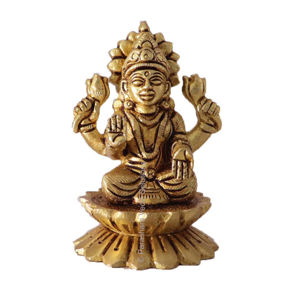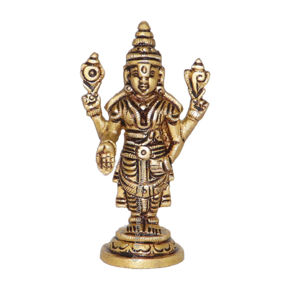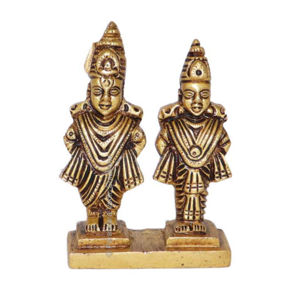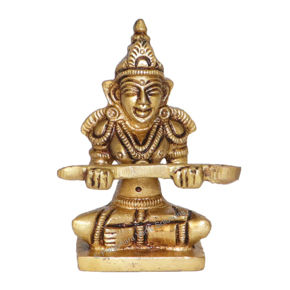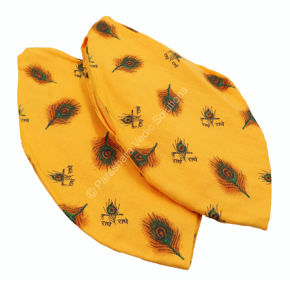Rudraksh
The word Rudraksha is a combination of two Sanskrit words – Rudra and Aksha, which denote the tears from the eyes of Lord Shiva. It is a divine blessing for mankind. Since times immemorial, the ancient sages have worn rudraksha beads and used the rosary for meditational and spiritual pursuits.
The Rudraksha is a bead with very powerful vibrations. It cleanses the aura of the wearer. It has a positive impact on health, and exercises a calming influence on the mental state. It is known to reduce blood pressure, cure skin ailments, soothe the nervous system and control stress levels. It serves as a protective barrier against negative energy. Rudraksha beads have powerful electro-magnetic properties and also improve concentration, focus and mental stamina.
The classics have written in length about the healing power of the bead. Each bead is a divine object and induces us to confess our sins and start afresh. It is a powerful medium for enhancing spirituality.
It inculcates the feeling of an all pervasive universal being. The rudraksha mala is also called Aksha mala. All the characters of the Sanskrit language are based on sounds and we all know that Lord Shiva's musical instrument Damru created the Pratyaharas from which the 50 characters were generated. The Akshar name given to characters denotes that letters and the akshar like sounds cannot be destroyed. The Rudraksha seeds in a mala represent these sounds and the person wearing it becomes a part of the cosmos. The beads have an uneven surface, which give a constant stimulation and acu-pressure like effect. This is good for the blood circulation and the nerves.
Apart from external uses, Rudraksha is also used and prescribed with Ayurvedic herbs. It acts as an anticonvulsant and analgesic on the nervous system. The six mukhi beads are used in the treatment of epilepsy and hysteria. The ten mukhi beads are used in reducing mental stress and strain. It is good for liver ailments like jaundice and gastrointestinal system disorders. Three mukhi rudrakshas cure malaria and indigestion. Three and five mukhi beads are effective in the treatment of blood pressure and respiratory problems. Nine mukhi beads relate to reproductive organs and have anti pyretic qualities. Skin ailments are cured by four mukhi beads. These beads are taken orally and externally in the form of Him (frozen), Kvatham, Milk,Bhasma (ash), Vibhuti, Tailam (oil), Kalkam, Mandap, Kirtanan, Mala etc.
Physical composition of a Rudraksha
The technical name of the Rudraksha tree is Elaeocarpus Ganitrus. It is a fruit as well as a seed. It grows in bunches, blooms in May and June and ripens from September to November. The fruit is circular and light green in color. A hard pulp surrounds the seed. This is then kept in water for a number of days and then the rudraksha is taken out after peeling off the pulp. The rudraksha berry was first spotted in Indonesia. It is also grown in Java, Korea, Malaysia, Taiwan, China, North India and Nepal. It is also found at a specific altitude in the Himalayas. The Rudraksha bead is made up of carbon, hydrogen, nitrogen, oxygen and other elements in combined form. It has 50.03 % carbon, 0.95% nitrogen, 17.89% hydrogen and 30.53% oxygen.
Arkam 5 mukhi Rudraksh Kantha Certified/ Rudraksha Kantha for wearing and worship/ Rudraksh Mala Big/ Five faced Rudraksh Kantha Mala (Size: 18-22mm, Length: 35inches, Beads: 54+1)
Arkam 5 mukhi Rudraksh Kantha Certified/ Rudraksha Kantha for wearing and worship/ Rudraksh Mala Big/ Five faced Rudraksh Kantha Mala with Padding (Size: 18-22mm, Length: 75inches, Beads: 108+1)
Arkam 5 mukhi Rudraksh Kantha/ Rudraksha Kantha for wearing and worship/ Rudraksh Mala Big/ Five faced Rudraksh Kantha Mala with Padding (Size: 18-22mm, Length: 35inches, Beads: 54+1)
ARKAM Eight Mukhi Rudraksha Certified/ Original Nepali 8 Mukhi Rudraksh/ Natural 8 faced Rudraksha (Brown) with Certificate and Puja Instructions
ARKAM Eight Mukhi Rudraksha Certified/ Original Nepali 8 Mukhi Rudraksh/ Natural 8 faced Rudraksha with Silver Pendant (Brown) with Certificate and Puja Instructions
ARKAM Eleven Mukhi Rudraksha Certified/ Original Nepali 11 Mukhi Rudraksh/ Natural 11 faced Rudraksha (Brown) with Certificate and Puja Instructions
ARKAM Eleven Mukhi Rudraksha Certified/ Original Nepali 11 Mukhi Rudraksh/ Natural 11 faced Rudraksha with Silver Pendant (Brown) with Certificate and Puja Instructions
ARKAM Five Mukhi Rudraksha Certified/ Original Nepali 5 Mukhi Rudraksh/ Natural 5 faced Rudraksha (Brown) with Certificate and Puja Instructions
ARKAM Five Mukhi Rudraksha Certified/ Original Nepali 5 Mukhi Rudraksh/ Natural 5 faced Rudraksha with Silver Pendant (Brown) with Certificate and Puja Instructions
ARKAM Four Mukhi Rudraksha Certified/ Original Nepali 4 Mukhi Rudraksh/ Natural 4 faced Rudraksha (Brown) with Certificate and Puja Instructions
ARKAM Four Mukhi Rudraksha Certified/ Original Nepali 4 Mukhi Rudraksh/ Natural 4 faced Rudraksha with Silver Pendant (Brown) with Certificate and Puja Instructions
ARKAM Fourteen Mukhi Rudraksha Certified/ Original Nepali 14 Mukhi Rudraksh/ Natural 14 faced Rudraksha with Silver Pendant (Brown) with Certificate and Puja Instructions
ARKAM Ganesh Rudraksha Certified/ Original Nepali Ganesh Rudraksh/ Natural Ganesh Rudraksha (Brown) with Certificate and Puja Instructions
ARKAM Ganesh Rudraksha Certified/ Original Nepali Ganesh Rudraksh/ Natural Ganesh Rudraksha with Silver Pendant (Brown) with Certificate and Puja Instructions
ARKAM Gauri Shankar Rudraksha Certified/ Original Nepali Gauri Shankar Rudraksh/ Natural Gauri Shankar Rudraksha (Brown) with Certificate and Puja Instructions
ARKAM Gauri Shankar Rudraksha Certified/ Original Nepali Gauri Shankar Rudraksh/ Natural Gauri Shankar Rudraksha with Silver Pendant (Brown) with Certificate and Puja Instructions
ARKAM Gold Plated Rudraksha Bracelet / Rudraksha Bracelet for men and women / Five Mukhi Rudraksha Bracelet (Length: 8", Golden)
ARKAM Gold Plated Rudraksha Bracelet in Rings / Rudraksha Bracelet for men and women / Five Mukhi Rudraksha Bracelet (Length: 8", Golden)
ARKAM Nine Mukhi Rudraksha Certified/ Original Nepali 9 Mukhi Rudraksh/ Natural 9 faced Rudraksha (Brown) with Certificate and Puja Instructions
ARKAM Nine Mukhi Rudraksha Certified/ Original Nepali 9 Mukhi Rudraksh/ Natural 9 faced Rudraksha with Silver Pendant (Brown) with Certificate and Puja Instructions
ARKAM One Mukhi Rudraksha Certified Kaju Dana/ Original 1 Mukhi Rudraksh Kaju Dana/ Natural 1 faced Half-moon Rudraksha (Brown) with Certificate and Puja Instructions
ARKAM One Mukhi Rudraksha Certified Kaju Dana/ Original 1 Mukhi Rudraksh Kaju Dana/ Natural 1 faced Rudraksha with Silver Pendant (Brown) with Certificate and Puja Instructions
Arkam Rudraksh Mala with Silver Capping Certified/ Silver Rudraksh Mala for Men and Women/ Rudraksha mala Silver Cap Original/ Rudraksh Mala Set in Silver (Size: 6mm, Length: 24 inches, Beads: 54+1)
Arkam Rudraksh Mala with Silver Capping Certified/ Silver Rudraksh Mala for Men and Women/ Rudraksha mala Silver Cap Original/ Rudraksh Mala Set in Silver (Size: 7mm, Length: 27 inches, Beads: 54+1)
Arkam Rudraksh Pearl Mala/ 100% Natural Rudraksha and Pearl Mala with Gold Metal Capping/ Original Rudraksha Pearl Rosary/ Rudraksh Moti Mala/ Rudraksha Moti Rosary (Size: 6mm, Beads: 54+1, Length: 26 inches)
Arkam Rudraksh Pearl Mala/ 100% Natural Rudraksha and Pearl Mala with Gold Metal Capping/ Original Rudraksha Pearl Rosary/ Rudraksh Moti Mala/ Rudraksha Moti Rosary (Size: 8mm, Beads: 54+1, Length: 32 inches)
Arkam Rudraksha Mala Certified/Natural Rudraksh Mala/Original Rudraksha mala/Rudraksha Mala for jaap/ 12mm Rudraksha Rosary (Size: 12mm, Beads: 108+1)
Arkam Rudraksha Mala Sumarni/Natural Rudraksh Mala/Original Rudraksha mala/Rudraksha Mala for jaap/ 12mm Rudraksha Rosary (Size: 12mm, Beads: 27+1)
Arkam Rudraksha Mala/ Natural Rudraksh Mala/ Original Rudraksha mala/ Rudraksha Mala for jaap/ 8mm Rudraksha Rosary (Size: 8mm, Beads: 108+1)
Arkam Rudraksha Mala/ Natural Rudraksh Mala/ Original Rudraksha mala/ Rudraksha Mala for men and women/ 7mm Rudraksha Rosary (Size: 7mm, Beads: 108+1)
Arkam Rudraksha Mala/ Natural Rudraksh Mala/ Original Rudraksha mala/ Small Rudraksham Mala/ 4mm Rudraksha Rosary (Size: 4mm, Beads: 108+1)
Arkam Rudraksha Mala/ Natural Rudraksh Mala/ Original Rudraksha mala/ Small Rudraksham Mala/ 5mm Rudraksha Rosary (Size: 5mm, Beads: 108+1)
Arkam Rudraksha Mala/ Natural Rudraksh Mala/ Original Rudraksha mala/ Small Rudraksham Mala/ 6mm Rudraksha Rosary (Size: 6mm, Beads: 108+1)
Arkam Rudraksha Mala/Natural Rudraksh Mala/Original Rudraksha mala/Rudraksha Mala for jaap/ 10mm Rudraksha Rosary (Size: 10mm, Beads: 108+1)
Arkam Rudraksha Mala/Natural Rudraksh Mala/Original Rudraksha mala/Rudraksha Mala for jaap/ 9mm Rudraksha Rosary (Size: 9mm, Beads: 108+1)
ARKAM Seven Mukhi Rudraksha Certified/ Original Nepali 7 Mukhi Rudraksh/ Natural 7 faced Rudraksha (Brown) with Certificate and Puja Instructions
ARKAM Seven Mukhi Rudraksha Certified/ Original Nepali 7 Mukhi Rudraksh/ Natural 7 faced Rudraksha with Silver Pendant (Brown) with Certificate and Puja Instructions
ARKAM Six Mukhi Rudraksha Certified/ Original Nepali 6 Mukhi Rudraksh/ Natural 6 faced Rudraksha (Brown) with Certificate and Puja Instructions
ARKAM Six Mukhi Rudraksha Certified/ Original Nepali 6 Mukhi Rudraksh/ Natural 6 faced Rudraksha with Silver Pendant (Brown) with Certificate and Puja Instructions
ARKAM Ten Mukhi Rudraksha Certified/ Original Nepali 10 Mukhi Rudraksh/ Natural 10 faced Rudraksha (Brown) with Certificate and Puja Instructions
ARKAM Ten Mukhi Rudraksha Certified/ Original Nepali 10 Mukhi Rudraksh/ Natural 10 faced Rudraksha with Silver Pendant (Brown) with Certificate and Puja Instructions
ARKAM Thirteen Mukhi Rudraksha Certified/ Original Nepali 13 Mukhi Rudraksh/ Natural 13 faced Rudraksha (Brown) with Certificate and Puja Instructions
ARKAM Thirteen Mukhi Rudraksha Certified/ Original Nepali 13 Mukhi Rudraksh/ Natural 13 faced Rudraksha with Silver Pendant (Brown) with Certificate and Puja Instructions
ARKAM Three Mukhi Rudraksha Certified/ Original Nepali 3 Mukhi Rudraksh/ Natural 3 faced Rudraksha (Brown) with Certificate and Puja Instructions
ARKAM Three Mukhi Rudraksha Certified/ Original Nepali 3 Mukhi Rudraksh/ Natural 3 faced Rudraksha with Silver Pendant (Brown) with Certificate and Puja Instructions
ARKAM Twelve Mukhi Rudraksha Certified/ Original Nepali 12 Mukhi Rudraksh/ Natural 12 faced Rudraksha (Brown) with Certificate and Puja Instructions
ARKAM Twelve Mukhi Rudraksha Certified/ Original Nepali 12 Mukhi Rudraksh/ Natural 12 faced Rudraksha with Silver Pendant (Brown) with Certificate and Puja Instructions
ARKAM Two Mukhi Kaju Rudraksha Certified/ Original 2 Mukhi Rudraksh/ Natural 2 faced Rudraksha (Brown) with Certificate and Puja Instructions
ARKAM Two Mukhi Oval Rudraksha Certified/ Original 2 Mukhi Rudraksh/ Natural 2 faced Rudraksha (Brown) with Certificate and Puja Instructions
ARKAM Two Mukhi Oval Rudraksha Certified/ Original 2 Mukhi Rudraksh/ Natural 2 faced Rudraksha with Silver Pendant (Brown) with Certificate and Puja Instructions
- 1
- 2

